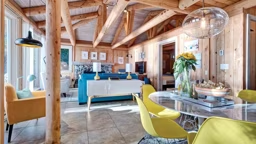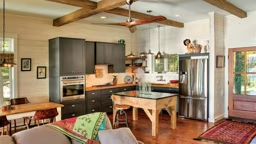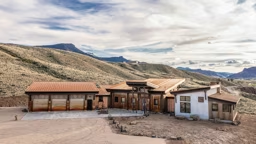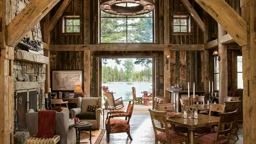Living off the grid. It sounds so smooth coming off the tongue, and it certainly appeals to the inner caveman that dwells inside many cabin owners. Nestled in a technologically-isolated retreat, you can feel well-positioned to weather life’s storms, both literal and figurative.
But whether your off-the-grid situation is a result of philosophical choice or practical necessity, at times the lack of modern-day niceties can be a pain in the neck. So, here are a few tips to help you enjoy that time unplugging just a wee bit more.
But whether your off-the-grid situation is a result of philosophical choice or practical necessity, at times the lack of modern-day niceties can be a pain in the neck. So, here are a few tips to help you enjoy that time unplugging just a wee bit more.
Cooler coolers
Hunter-gather extraordinaire, Les Stroud of “Survivorman” fame, said it all: After a few days on the bush, you crave one of two things: something warm or something cold.
For cabins without an electrical or propane refrigerator, keeping food cool usually means relying on your cooler. For a quick day trip, a $30 cooler and a couple bags of cheap convenience-store ice will do the trick, provided you keep the cooler out of the sun.
But for extended stays, you need something with a bit more insulating power. Today’s modern coolers, like those offered by Yeti and Pelican, can keep contents icy for upwards of a week. For best results, place the cooler itself in the freezer for a day or so first to cool the walls down, then pack with block, not cubed, ice that is at the lowest possible temperature (subzero ice will keep things colder much longer than 31oF ice). Don’t leave open spaces in the cooler, and freeze any liquids or solids you can before placing in the cooler.
These coolers are expensive ($260–$480 for a Pelican), and preparation may take a little more time. Still, it can be hard to put a price tag on a cold drink after five days away from electricity.
Hunter-gather extraordinaire, Les Stroud of “Survivorman” fame, said it all: After a few days on the bush, you crave one of two things: something warm or something cold.
For cabins without an electrical or propane refrigerator, keeping food cool usually means relying on your cooler. For a quick day trip, a $30 cooler and a couple bags of cheap convenience-store ice will do the trick, provided you keep the cooler out of the sun.
But for extended stays, you need something with a bit more insulating power. Today’s modern coolers, like those offered by Yeti and Pelican, can keep contents icy for upwards of a week. For best results, place the cooler itself in the freezer for a day or so first to cool the walls down, then pack with block, not cubed, ice that is at the lowest possible temperature (subzero ice will keep things colder much longer than 31oF ice). Don’t leave open spaces in the cooler, and freeze any liquids or solids you can before placing in the cooler.
These coolers are expensive ($260–$480 for a Pelican), and preparation may take a little more time. Still, it can be hard to put a price tag on a cold drink after five days away from electricity.
Lighting options
In years past, sunset at an off-the-grid cabin meant relying on candlelight, firelight or lanterns. And while propane lanterns and lights are still a great option sans electricity, the advancement of LED lights and solar technology means you can light up your cabin without relying on propane cylinders or a noisy generator.
One of the best options is to couple a solar panel with a deep-cycle battery, and then hook up the battery to DC wiring that runs to DC-powered LED lights.
Although it may be tempting to simply install a DC-to-AC inverter and then plug the battery into existing AC wiring (which is commonly used if you have a generator), don’t do it. Inverters use energy to transform the current from DC to AC, wasting precious battery life. Stick with DC wiring and fixtures throughout the system for the best performance.
Prevent nighttime dry mouth
Problem: Wood fires work great to drive away the chill of a winter night, but they also tend to dry out the cabin air more than propane or natural gas furnaces. For some, extremely dry air can be difficult to breathe on a regular basis.
Solution: The solution is as low-tech as it is simple – before bed, place a large cooking pot filled with water on the woodstove. The wood fire turns the water to steam, releasing water into the cabin even as it sucks up moisture in the air, keeping the air slightly more humid. As a bonus, you’ll have a reservoir of warm water waiting for your morning washing when you wake up!
In years past, sunset at an off-the-grid cabin meant relying on candlelight, firelight or lanterns. And while propane lanterns and lights are still a great option sans electricity, the advancement of LED lights and solar technology means you can light up your cabin without relying on propane cylinders or a noisy generator.
One of the best options is to couple a solar panel with a deep-cycle battery, and then hook up the battery to DC wiring that runs to DC-powered LED lights.
Although it may be tempting to simply install a DC-to-AC inverter and then plug the battery into existing AC wiring (which is commonly used if you have a generator), don’t do it. Inverters use energy to transform the current from DC to AC, wasting precious battery life. Stick with DC wiring and fixtures throughout the system for the best performance.
Prevent nighttime dry mouth
Problem: Wood fires work great to drive away the chill of a winter night, but they also tend to dry out the cabin air more than propane or natural gas furnaces. For some, extremely dry air can be difficult to breathe on a regular basis.
Solution: The solution is as low-tech as it is simple – before bed, place a large cooking pot filled with water on the woodstove. The wood fire turns the water to steam, releasing water into the cabin even as it sucks up moisture in the air, keeping the air slightly more humid. As a bonus, you’ll have a reservoir of warm water waiting for your morning washing when you wake up!
Hot showers
Far too many cabin trips are cut short by the driving need for a hot shower. While you can build a solar outdoor shower for cleaning up (like the DIY project featured in the August 2011 issue of Cabin Life), don’t feel like you have to spend hundreds of dollars or long hours building a shower.
A standard, heavy-duty black contractor trash bag can hold about 3–5 gallons of water without tearing open. Simply fill one of these bags with water, tie a knot in the bag, and suspend 6–7 feet high (tree limbs can work well) in direct sunlight. After an hour or two, feel the outside of the bag. When it’s warm enough, strip down to whatever level of attire is appropriate and punch a few holes in the bag. Been a long, dirty weekend? Go ahead and splurge and hang two or three bags up (an average shower flow is about 5 gallons per minute).
Far too many cabin trips are cut short by the driving need for a hot shower. While you can build a solar outdoor shower for cleaning up (like the DIY project featured in the August 2011 issue of Cabin Life), don’t feel like you have to spend hundreds of dollars or long hours building a shower.
A standard, heavy-duty black contractor trash bag can hold about 3–5 gallons of water without tearing open. Simply fill one of these bags with water, tie a knot in the bag, and suspend 6–7 feet high (tree limbs can work well) in direct sunlight. After an hour or two, feel the outside of the bag. When it’s warm enough, strip down to whatever level of attire is appropriate and punch a few holes in the bag. Been a long, dirty weekend? Go ahead and splurge and hang two or three bags up (an average shower flow is about 5 gallons per minute).
FIRE SAFETY
Dwelling fires can be deadly enough for rural cabin owners and homeowners who are connected to the grid. For off-the-grid properties – which often rely on wood fires and candles for heat, cooking, and light – blazes are not only a higher risk, but can quickly cause serious damage to your property, endangering the life of you and your loved ones.
Extinguishers
It is essential to maintain proper working fire extinguishers within the cabin, replacing any canister that has a cracked hose, wobbly handle, or a gauge outside the green working range. For older canisters without a gauge, either replace with a new canister or have it serviced annually. Rain barrels with easily removable lids and a couple buckets provide an extra level of fire suppression. If you want to get fancy, you can attach a soaker hose to your rain barrel.
Wildfire
Wildfires are another distinct threat. Maintain large safety margins within 30 feet around your cabin:
Dwelling fires can be deadly enough for rural cabin owners and homeowners who are connected to the grid. For off-the-grid properties – which often rely on wood fires and candles for heat, cooking, and light – blazes are not only a higher risk, but can quickly cause serious damage to your property, endangering the life of you and your loved ones.
Extinguishers
It is essential to maintain proper working fire extinguishers within the cabin, replacing any canister that has a cracked hose, wobbly handle, or a gauge outside the green working range. For older canisters without a gauge, either replace with a new canister or have it serviced annually. Rain barrels with easily removable lids and a couple buckets provide an extra level of fire suppression. If you want to get fancy, you can attach a soaker hose to your rain barrel.
Wildfire
Wildfires are another distinct threat. Maintain large safety margins within 30 feet around your cabin:
- Reduce evergreen trees.
- Remove small trees, brush, leaves and pine needles.
- Keep your roof and gutters clear of leaves and pine needles.
- Prune lower tree limbs to a height of 6–10 feet.
 Dreamstime.com
Dreamstime.com 

 Thinkstock.com
Thinkstock.com 










